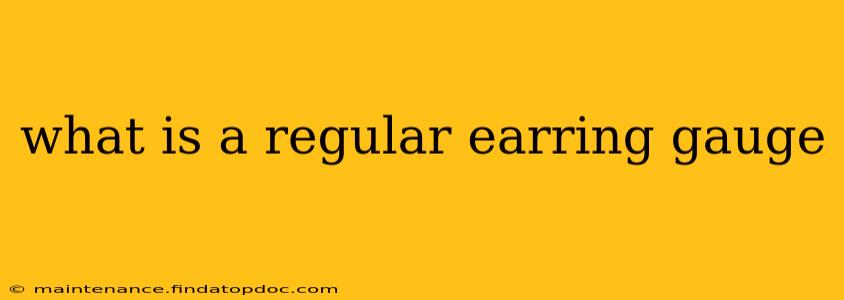What is a Regular Earring Gauge? Understanding Ear Piercing Sizes
The term "regular" earring gauge is subjective and depends heavily on context. There isn't one universally agreed-upon size considered "regular." However, we can define what's commonly considered standard and explore the spectrum of gauge sizes used for earrings.
The gauge, or gauge size, refers to the thickness of the earring post or wire. It's measured in gauge numbers, a system inversely proportional to the diameter. A lower gauge number indicates a thicker post, while a higher gauge number indicates a thinner one. This is often confusing for newcomers to ear piercing.
Understanding the Gauge Number System:
Think of it like this: a 16-gauge earring post is thicker than a 20-gauge post. The larger the gauge number, the thinner the post. This is crucial because thinner posts are better suited for freshly pierced ears, minimizing trauma and promoting faster healing.
What Gauge Size is Considered Standard for Ear Piercings?
While there's no single "regular" size, 20 gauge (0.8mm) is frequently cited as the most common gauge for initial ear piercings. Many piercers will use this size because it's a good balance between being thin enough to minimize irritation during healing and thick enough to be durable and less prone to bending.
You'll frequently see 18-gauge (1.0mm) and 16-gauge (1.2mm) earrings as well, often used after the initial healing period. These thicker gauges can accommodate heavier earrings and are more resistant to damage.
What Gauge Size is Used for Other Piercings?
The gauge size isn't only used for earlobe piercings. Different piercings may utilize varying gauges depending on their placement and healing requirements. For instance:
- Cartilage piercings: Often start with 16g or even 14g (1.6mm). Cartilage takes longer to heal, and using a thicker gauge can sometimes be preferred.
- Industrial piercings: Typically utilize a 14g or 16g gauge.
What Gauge Earring Can I Wear After Healing?
Once your piercing is fully healed (this can vary significantly depending on the piercing location and individual factors, often ranging from 6-12 months), you'll have more options regarding earring gauge. Many people eventually transition to larger gauges, or smaller (thinner) gauges, depending on their personal preference and the style of earrings they prefer. It is always advisable to consult with your piercer before changing gauges.
What Are the Most Common Earring Gauges?
Here's a quick rundown of frequently used gauges in ear piercing:
- 20 Gauge (0.8mm): Very common for initial lobe piercings, considered by many to be the standard.
- 18 Gauge (1.0mm): Frequently used after the initial healing period, often for lobe piercings and some cartilage piercings.
- 16 Gauge (1.2mm): Common for cartilage piercings and heavier earrings once fully healed.
- 14 Gauge (1.6mm): Used for cartilage piercings and for those who want thicker posts.
Remember: Always consult with your piercer about the appropriate gauge size for your piercing. They can provide personalized recommendations based on your specific anatomy and the type of piercing you're getting. Using the wrong gauge can lead to irritation, infection, or even damage to the piercing.
